2012年职称英语理工类完形填空新增文章PDF版_含练习解析及译文_
- 格式:pdf
- 大小:347.43 KB
- 文档页数:23
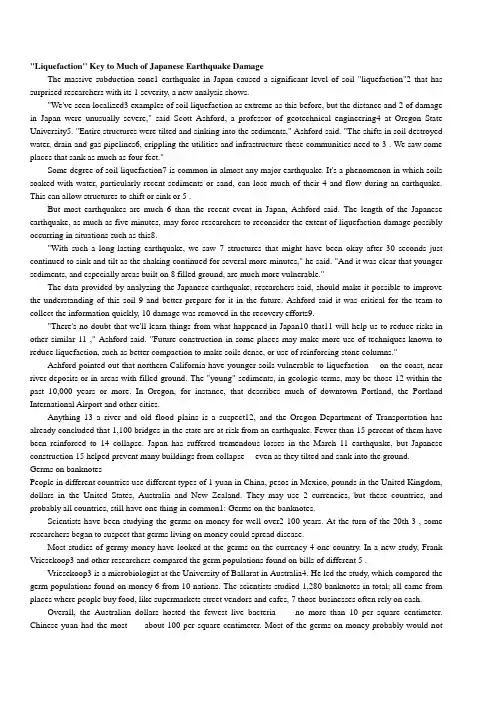
"Liquefaction" Key to Much of Japanese Earthquake DamageThe massive subduction zone1 earthquake in Japan caused a significant level of soil "liquefaction"2 that has surprised researchers with its 1 severity, a new analysis shows."We've seen localized3 examples of soil liquefaction as extreme as this before, but the distance and 2 of damage in Japan were unusually severe," said Scott Ashford, a professor of geotechnical engineering4 at Oregon State University5. "Entire structures were tilted and sinking into the sediments," Ashford said. "The shifts in soil destroyed water, drain and gas pipelines6, crippling the utilities and infrastructure these communities need to 3 . We saw some places that sank as much as four feet."Some degree of soil liquefaction7 is common in almost any major earthquake. It's a phenomenon in which soils soaked with water, particularly recent sediments or sand, can lose much of their 4 and flow during an earthquake. This can allow structures to shift or sink or 5 .But most earthquakes are much 6 than the recent event in Japan, Ashford said. The length of the Japanese earthquake, as much as five minutes, may force researchers to reconsider the extent of liquefaction damage possibly occurring in situations such as this8."With such a long-lasting earthquake, we saw 7 structures that might have been okay after 30 seconds just continued to sink and tilt as the shaking continued for several more minutes," he said. "And it was clear that younger sediments, and especially areas built on 8 filled ground, are much more vulnerable."The data provided by analyzing the Japanese earthquake, researchers said, should make it possible to improve the understanding of this soil 9 and better prepare for it in the future. Ashford said it was critical for the team to collect the information quickly, 10 damage was removed in the recovery efforts9."There's no doubt that we'll learn things from what happened in Japan10 that11 will help us to reduce risks in other similar 11 ," Ashford said. "Future construction in some places may make more use of techniques known to reduce liquefaction, such as better compaction to make soils dense, or use of reinforcing stone columns."Ashford pointed out that northern California have younger soils vulnerable to liquefaction ---on the coast, near river deposits or in areas with filled ground. The "young" sediments, in geologic terms, may be those 12 within the past 10,000 years or more. In Oregon, for instance, that describes much of downtown Portland, the Portland International Airport and other cities.Anything 13 a river and old flood plains is a suspect12, and the Oregon Department of Transportation has already concluded that 1,100 bridges in the state are at risk from an earthquake. Fewer than 15 percent of them have been reinforced to 14 collapse. Japan has suffered tremendous losses in the March 11 earthquake, but Japanese construction 15 helped prevent many buildings from collapse ---even as they tilted and sank into the ground.Germs on banknotesPeople in different countries use different types of 1 yuan in China, pesos in Mexico, pounds in the United Kingdom, dollars in the United States, Australia and New Zealand. They may use 2 currencies, but these countries, and probably all countries, still have one thing in common1: Germs on the banknotes.Scientists have been studying the germs on money for well over2 100 years. At the turn of the 20th 3 , some researchers began to suspect that germs living on money could spread disease.Most studies of germy money have looked at the germs on the currency 4 one country. In a new study, Frank Vriesekoop3 and other researchers compared the germ populations found on bills of different 5 .Vriesekoop3 is a microbiologist at the University of Ballarat in Australia4. He led the study, which compared the germ populations found on money 6 from 10 nations. The scientists studied 1,280 banknotes in total; all came from places where people buy food, like supermarkets street vendors and cafes, 7 those businesses often rely on cash.Overall, the Australian dollars hosted the fewest live bacteria ---- no more than 10 per square centimeter. Chinese yuan had the most ---- about 100 per square centimeter. Most of the germs on money probably would notcause harm.What we call "paper" money usually isn't made from paper. The U. S. dollar, for example, is printed on fabric that is mostly 8 .Different countries may use different 9 to print their money. Some of the currencies studied by Vriesekoop and his 10 such as the American dollar were made from cotton. Others were made from polymers.The three 11 with the lowest numbers of bacteria were all printed on polymers. They included the Australian dollar, the New Zealand dollar and some Mexican pesos.The other currencies were printed on fabric made 12 of cotton. Fewer germs lived on the polymer notes. This connection suggests that 13 have a harder time staying alive on polymer surfaces. Scientists need to do more studies to understand how germs live on money-----and whether or not we need to be concerned. Vnesekoop is now starting a study that will 14 the amounts of time bacteria can stay alive on different types of bills.Whatever Vriesekoop finds, the fact remains: Paper money harbors germs We should wash our 15 after touching it; after all5, you never know where your money 's been. Or what's living on it.Solar Power without Solar CellsA dramatic and surprising magnetic effect of light discovered by University of Michigan1 researchers could lead to solar power without traditional semiconductor-based solar cells.The researchers found a way to make an "optical 1 ," said Stephen Rand, a professor in the departments of Electrical Engineering and Computer Science, Physics and Applied Physics.Light has electric and magnetic components. Until now, scientists thought the 2 of the magnetic field were so weak that they could be ignored. What Rand and his colleagues found is that at the right intensity, when light is traveling through a material that does not conduct electricity, the light field can generate magnetic effects that are 100 million times stronger than 3 expected. 4 these circumstances, the magnetic effects develop strength equivalent to a strong electric effect."This could lead to a new kind of solar cell without semiconductors and without absorption to produce charge separation," Rand said. "In solar cells, the 5 goes into a material, gets absorbed and creates heat. Here, we expect to have a very low heat load2. Instead of the light being absorbed, energy is stored in the magnetic moment3. Intense magnetization can be induced by intense light and then it is ultimately capable of providing a capacitive power 6."What makes this possible is a previously undetected brand of "optical rectification4," says William Fisher, a doctoral student5 in applied physics. In traditional optical rectification, light's electric field causes a charge separation, or a pulling 7 of the positive and negative charges6 in a material. This sets up a voltage, similar to 8 in a battery.Rand and Fisher found that under the right circumstances and in right types of materials, the light's magnetic field can also create optical rectification. The light must be shone through7 a 9 that does not 10 electricity, such as glass. And it must be focused to an intensity of 10 million watts per square centimeter8. Sunlight isn't this intense on its own, but new materials are being sought that would work at lower intensities, Fisher said."In our most recent paper, we show that incoherent light9 like sunlight is theoretically almost as. 11 in producing charge separation as laser light is," Fisher said.This new 12 could make solar power cheaper, the researchers say. They predict that with improved materials they could achieve 10 percent efficiency in 13 solar power to useable energy. That's equivalent to today's commercial-grade solar cells."To manufacture 14 solar cells, you have to do extensive semiconductor processing," Fisher said. "All we would need are lenses to focus the light and a fiber to guide it. Glass works for 15 . It's already made in bulk10, and it doesn't require as much processing. Transparent ceramics might be even better."Chicken Soup for the Soul:Comfort Food Fights LonelinessMashed potatoes, macaroni and cheese, may be bad for your arteries.1 according to a study in Psychological Science, they're good for your heart and 2 .The study focuses on "comfort food" and how it makes people feel."For me 3 ,food has always played a big role in my family," says Jordan Troisi, a graduate student at the University of Buffalo, and lead author on the study.The study came out of the research program of his co-author Shira Gabriel.It has 4 non-human things that may affect human emotions.Some people reduce loneliness by bonding with their 5 TV show, building virtual relationships with a pop song singer or looking at pictures of loved ones.Troisi and Gabriel wondered if comfort food could have the same effect 6 making peoplethink of their nearest and dearest. In one experiment, in order to make 7 feel lonely, the researchers had them write for six minutes about a fight with someone close to them.Others were given an emotionally neutral writing assignment. Then, some people in each 8 wrote about the experience of eating a comfort food and others wrote about eating a new food.9 ,the researchers had participants 10 questions about their levels of loneliness.Writing about a fight with a close person made people feel lonely.But people who were generally 11 in their relationships would feel less lonely by writing about a comfort food."We have found that comfort foods are consistently associated with those close to us."says Troisi."Thinking about or consuming these foods later then serves as a reminder of those close others."In 12 essays on comfort food, many people wrote about the 13 of eating food with family and friends. In another experiment, 14 chicken soup in the lab made people think more about relationships, but only if they considered chicken soup to be a comfort food.This was a question they had been asked long before the experiment, along with many other questions, so they wouldn't remember it. Throughout everyone's daily lives they experience stress, often associated with our 15 with others," Troisi says."Comfort food Can be an easy remedy for loneliness.Climate Change Poses Major Risks for Unprepared CitiesA new examination of urban policies has been 1 recently by Patricia Romero Lankao.She is a sociologist specializing in climate change and 2 development.She warns that many of the world's fast-growing urban areas,especially in developing countries.will likely suffer from the impacts of changing climate.Her work also concludes that most cities are failing to 3 emissions of carbon dioxide and other greenhouse 4 .These gases are known to affect the atmosphere."Climate change is a deeply local issue and poses profound threats to the growing cities of the world," says Romero Lankao. "But too few cities are developing effective strategies to 5 their residents."Cities are 6 sources of greenhouse gases.And urban populations are likely to be among those most severely affected by future climate change. Lankao's findings highlight ways in which city-residents are particularly vulnerable, and suggest policy interventions that could offer immediate and longer-term 7 .The locations and dense construction patterns of cities often place their populations at greater risk for natural disasters. Potential 8 associated with climate include storm surges and prolonged hot weather. Storm surges can flood coastal areas and prolonged hot weather can heat 9 paved cities more than surrounding areas.The impacts of such natural events can be more serious in an urban environment.For example,a prolonged heat wave can increase existing levels of air pollution,causing widespread health problems.Poorer neighborhoods that may 10 basic facilities such as drinking water or a dependable network of roads,are especially vulnerable to natural disasters.Many residents in poorer countries live in substandard housing 11 access to reliable drinking water,roads and basic services.Local governments, 12 ,should take measures to protect their residents."Unfortunately,they tend to move towards rhetoric 13 meaningful responses, Romero Lankao writes, " They don't impose construction standards that could reduce heating and air conditioning needs. They don't emphasize mass transit and reduce 14 use. In fact, many local governments are taking a hands-off approach." Thus, she urges them to change their 15 policies and to take strong steps to prevent the harmful effects of climate change on cities.Free Statins With Fast Food Could Neutralize Heart RiskFast food outlets could provide statin drugs free of 1 so that customers can reduce the heart disease dangers of fatty food, researchers at Imperial College London 2 in a new study.Statins reduce the 3 of unhealthy "LDL" cholesterol in the blood. A wealth of trial data has proven them to be highly effective at lowering a person's heart attack 4 .In a paper published in the American Journal of Cardiology,Dr Darrel Francis and colleagues calculate that the reduction in heart attack risk offered by a statin is 5 to offset the increase in heart attack risk from 6 a cheeseburger and drinking a milkshake.Dr Francis,from the National Heart and Lung Institute at Imperial College London,who is the senior author of the study, said:"Statins don't cut out a11 of the 7 effects of cheeseburgers and French fries.It's better to avoid fatty food altogether.But we've worked out that in terms of your 8 of having a heart attack. Taking a statin can reduce your risk to more or less the same 9 as a fast food meal increases it." "It's ironic that people are free to take as many unhealthv condiments in fast food outlets as they 10 , but statins, which are beneficial to heart health, have to be prescribed. It makes sense to make risk-reducing statins available just as easily as the unhealthy condiments that are l 1 free of charge.It would cost less than 5 pence per 1 2 一not much different to a sachet of sugar." Dr Francis said.When people engage in risky behaviours like driving or smoking, they're encouraged to take 13 that lower their risk, 1ike 14 a seatbelt or choosing cigarettes with filters. Taking a statin is a rational way of 1 5 some of the risks of eating a fatty meal.。
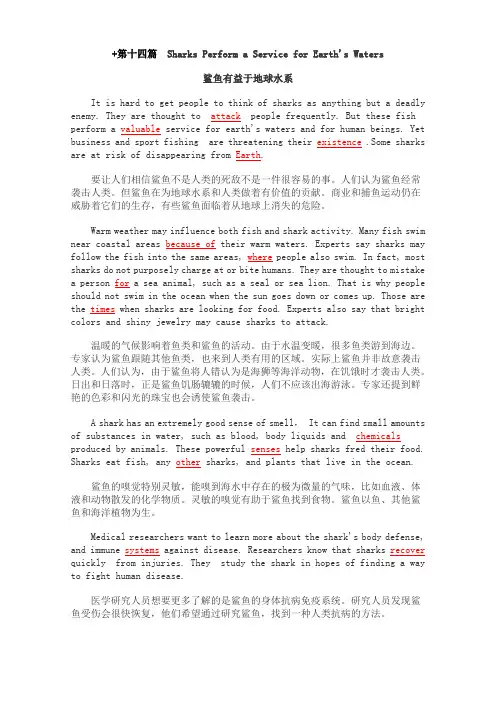
+第十四篇Sharks Perform a Service for Earth's Waters鲨鱼有益于地球水系It is hard to get people to think of sharks as anything but a deadly enemy. They are thought to attack people frequently. But these fish perform a valuable service for earth's waters and for human beings. Yet business and sport fishing are threatening their existence .Some sharks are at risk of disappearing from Earth.要让人们相信鲨鱼不是人类的死敌不是一件很容易的事。
人们认为鲨鱼经常袭击人类。
但鲨鱼在为地球水系和人类做着有价值的贡献。
商业和捕鱼运动仍在威胁着它们的生存,有些鲨鱼面临着从地球上消失的危险。
Warm weather may influence both fish and shark activity. Many fish swim near coastal areas because of their warm waters. Experts say sharks may follow the fish into the same areas, where people also swim. In fact, most sharks do not purposely charge at or bite humans. They are thought to mistake a person for a sea animal, such as a seal or sea lion. That is why people should not swim in the ocean when the sun goes down or comes up. Those are the times when sharks are looking for food. Experts also say that bright colors and shiny jewelry may cause sharks to attack.温暖的气候影响着鱼类和鲨鱼的活动。
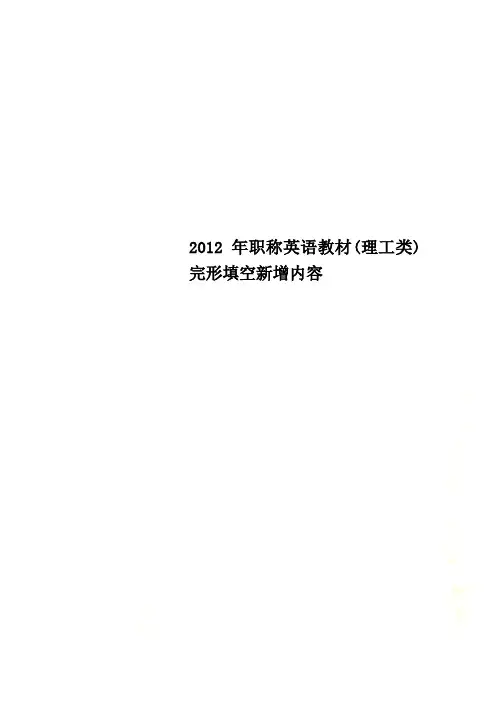
2012年职称英语教材(理工类)完形填空新增内容2012年职称英语教材(理工类)完形填空新增内容第三篇: Germs on BanknotesPeople in different countries use different typesof 1 :yuan in China,pesos in Mexico, pounds in the United Kingdom,dollars in the United States,Australia and New Zealand.They may use 2 currencies,but these countries,and probably all countries,still have onething in common:Germs on the banknotes.Scientists have been studying the germs on money for well over 100 years.At the turn of the20th 3 ,some researchers began to suspect that germs living on money could sprea disease.Most studies of germy money have looked at the germs on the currency 4 country.In a new study,Frank Vriesekoop and other researchers compared the germ populations found on bills of different 5 .Vriesekoop is a microbiologist at the University of Ballarat in Australia.He led the study,which compared the germ populations found on money 6 from 10 nations.The scientistsstudied 1,280 banknotes in total; all came from places where people buy food, like supermarkets,street vendors and cafes, 7 those businesses often rely on cash. Overall,the Australian dollars hosted the fewest live bacteria—no more than 10 persquare centimeter.Chinese yuan had the most——about 100 per square centimeter.Most of the germs on money probably would not cause harm.What we call “paper money” usually isn’t made from paper.The U.S.dollar,for example,In print on fabric that is mostly 8 Different countries may use different 9 to print their money.Some of the currencies studied by Vriesekoop and his 10 ,such as the American dollar,were made from cotton.Others were made from polymers.The three 11 with the lowest numbers of bacteria were all printed on polymers.They included the Australian dollar,the New Zealand dollar and some Mexican pesos.The other currencies were printed on fabric made 12 of cotton. Fewer germs lived on the polymer notes. This connection suggests that 13 have a harder time staying alive on polymer surfaces. Scientists need to do more studies to understand how germs live on money—and whether or not we need to be concerned.Vriesekoop is now starting a study thatwill 14 the amounts of time bacteria can stay alive ondifferent types of bills.Whatever Vriesekoop finds,the fact remains:Paper money harbors germs.We should wash our 1 5 after touching it after all, you never know where your money’s been.Or what’s living on it.第十篇 Chicken Soup for the Soul:Comfort FoodFights LonelinessMashed potatoes,macaroni and cheese,may be bad for your arteries. 1 according to a studyin Psychological Science,they’re good for your heart and 2 .The study focuses on“comfort food”and how it makes people feel.“For me 3 ,food has always played a big role in my family,”says Jordan Troisi, a graduate student at theUniversity of Buffalo,and lead author on the study.The study came out of the research program of his co—author Shira Gabriel.It has 4 non-human things that may affect human emotions.Some people reduce loneliness by bonding with their 5 TV show,building virtual relationships with a pop song singer or looking at pictures of loved ones.Troisi and Gabriel wondered if comfort food could have the sameeffect 6 making peoplethink of their nearest and dearest. In one experiment,in order to make 7 feel lonely,the researchers had them write for six minutes about a fight with someone close to them.Others were given an emotionally neutral writing assignment.Then,some people in each 8 wrote about the experience of eating a comfort food and others wrote about eating a new food. 9 ,the researchershad participants 10 questions about their levels of loneliness.Writing about a fight with a close person made people feel lonely.But people who were generally 11 in their relationships would feel less lonely by writing about a comfort food.“We have found that comfort foods are consistently associated with those close to us.”says Troisi.“Thinking about or consumi ng these foods later then serves as a reminder of those closeothers.”In 12 essays on comfort food,many people wrote about the 13 of eating food with family and friends. In another experiment, 14 chicken soup in the lab made people think more about relationships,but only if they considered chicken soup to be a comfort food.This was a question they had been asked long before the experiment,along with many other questions,so they wouldn’t remember it.Throughout everyone’s daily lives they experience stress,often associated with our 15 with others,“Troisi says.”Comfort food Can be an easy remedy for loneliness.练习:1.A but B if C though D while2.A personality B movement C emotions D will 3.A privately B usefully C awfully D personally 4.A looked for B looked at C lookedafter D looked up5.A favorite B trustful C boring D annoying6.A with B on C by D at7.A professors B participants Cassistants D scientists8.A group B class C section D part9.A Previously B Formally C Initially D Finally 10.A remember B explain C rewrite D complete 11.A sad B secure C shy D angry12.A your B our C his D their13.A accident B harm C experience D model 14.A eating B exchanging C buying D keepingl 5.A expressions B estimation C cooperationD connections第十一篇 Climate Change Poses Major Risks forUnprepared CitiesA new examlnation of urban policies hasbeen 1 recently by Patricia Romero Lankao.She is a sociologist specializing in climate changeand 2 development.She warns that many of theworld’s fast-growing urban areas,especially in developing countries.will likely suffer from the impacts of changing climate.Her work aso concludes that most cities are failing to 3 emissions of carbon dioxide and other greenhouse 4 .These gasesare known to affect the atmosphere.“Climate change is a deeply local issue and poses profound threats to the growing cities of the world,”says Romero Lankao.“But too few cities are developing effectivestrategies to 5 their residents."Cities are 6 sources of greenhouse gases.And urban populations are likely to be among those most severely affected by future climate change.Lankao’s findings highlight ways in which city-residents are particularly vulnerable,and suggest policy interventions that could offer immediate and longer-term 7 .The locations and dense construction patterns of cities often place their populatlons at greater risk for natural disasters.Potential 8 associated with climate include storm surges and prolonged hot weather.Storm surges can flood coastal areas and prolonged hot weathe can heat 9 paved cities more than surrounding areas.The impacts of such natural events can be more serious in an urban environment.For example,a prolonged heat wave can increase existing levels of air pollution,causing widespread health problems.Poorer neighborhoods that may 10 basic facilities such as drinking water or a dependable network of roads,are especiallyvnlnerable to natural disasters.Many residents in poorer countries live in substandardhousing 11 access to reliable drinking water,roads and basic services.Local governments, 12 ,should take measures to protect their residents.“Unfortunately,they tend to move towards rhetoric 13 meaningfulresponses, Romero Lankao writes.“They don’t impose construction standards that could reduce heating and air conditioning needs.They don't emphasize mass transit and reduce 14 use. ln fact,manylocal governments are taking ahands—off approach.”Thus,she urges themto change tneir 15 policies and to take strong steps to prevent the harmful effects of climate change on cities.1.A carry along B carried away C carried out D carried back2.A economic B industrial C rural D urban3.A reduce B increase C study D measure4.A crops B gases C fruits D Plant55.A educate B evaluate C protect D identify6.A doubtful B possible C repeatable D major7.A uses B chances C cures D benefits8.A threats B interests C functions D differences 9.A locally B heavily C suddenly D mildlyl0.A provide B improve C lack D update11.A without B with C in D on12.A moreover B therefore C however D though 13.A other than B more than C less than D rather than14.A train B automobile C bus D bike15.A idle B smart C busy D secure第十二篇 Free Statins With Fast Food CouldNeutralize Heart RiskFast food outlets could provide statin drugs freeof 1 so that customers can reduce the heart disease dangers of fatty food,researchers at Imperial College London 2 in a newstudy.Statins reduce the 3 ofunhealthy“LDL”cholesterol in the blood.A wealth of trial data has proven them to be highly effective at lowering a person’s heart attack 4 .In a paper published in the American Journal of Cardiology,Dr Darrel Francis and colleagues calculate that the reduction in heart attack risk offered by a statin is 5 to offset the increase in heart attack risk from 6 a cheeseburger and drinking a milkshake. Dr Francis,from the National Heart and Lung Institute at Imperial College London,who is the senior author of the study,said:“Statins don’t cut out a11 of the 7 effects of cheeseburgers and French fries.It’s better to avoid fatty food altogether.But we’ve worked out that in terms of your 8 of having a heart attack,taking a statin can reduce your risk to more or less the same 9 as a fast food meal increases it.”“It’s ironic that people are free to take as many unhealthv condiments in fast food outlets as they 10 ,but statins,which are beneficial to heart health, have to beprescribed.It makes sense to make risk-reducing statins available just as easily as the unhealthy condiments that are l 1 free of charge.It would cost less than 5 pence per 1 2 一not much different to a sachet of sugar。
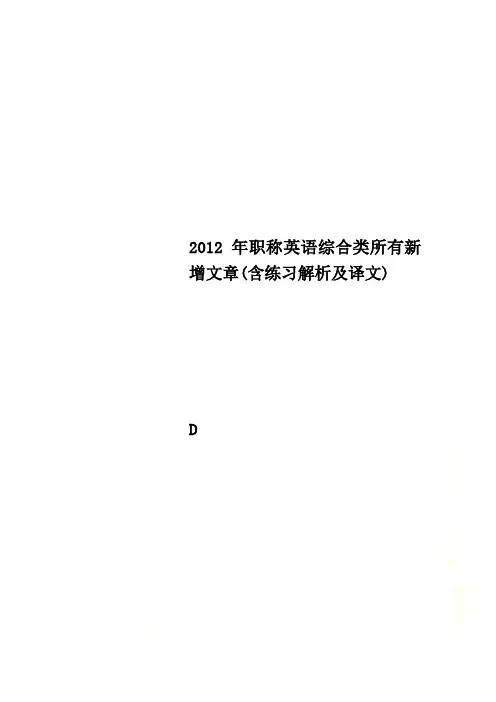
2012年职称英语综合类所有新增文章(含练习解析及译文)D2012年职称英语综合类新增文章(含练习解析及译文)+第三十七篇Pop Music in Africa+第三十八篇Why So Many Children?+第四十七篇Narrow Escape补全短文(2篇)第九篇Heat Is Killer*第十一篇Virtual Driver完形填空(15篇)第一篇 A Life with Birds第二篇 A Lucky Break第三篇Global Warming第四篇 A Success Story第五篇Traffic in Our Cities第六篇Teaching and learning*第七篇The Difference between Man and Computer*第八篇Look on The Bright Side*第九篇The First Bicycle*第十篇Working Mothers+第十一篇School Lunch+第十二篇 A Powerful Influence+第十三篇The Old Gate+第十四篇Family History+第十五篇Helen and Martin译文见最后注:1、+表示A级文章;*表示B即文章;其他为C级文章;2、阅读判断,请参见第4页;概括大意与完成句子,请参见第8页;阅读理解,请参见第13页;补全短文,请参见第43页3、2012年词汇部分与2011年教材相比未作任何变化。
阅读判断第七篇Moderate Earthquake Strikes England中度地震袭击英国A moderate earthquake struck parts of southeast England on 28 April 2007,toppling chimneys from houses and rousing residents from their beds. Several thousand people were left without power1in Kent County. One woman suffered minor head and neck injuries.2007年4月28日英格兰东南部地区发生中度地震一些房屋烟囱倒塌,许多居民半夜从睡梦中惊醒。
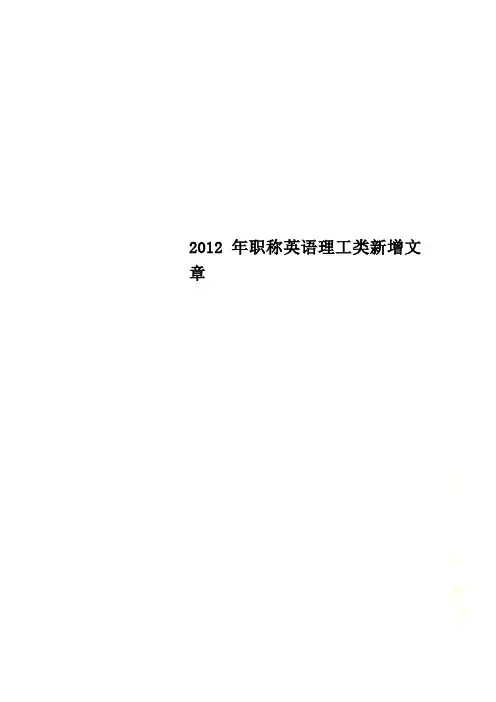
2012年职称英语理工类新增文章2012年职称英语理工类新增文章阅读理解(6篇)……………………3页第六篇 Making Light of1 Sleep第十九篇 Graphene's Superstrength1*第三+八篇 "Life Form Found" on Saturn's Titan *第四十篇 Teaching Math, Teaching Anxiety+第四+五篇 Teaching Math, Teaching Anxiety+第四十六篇Ants Have Big Impact on Environment as "Ecosystem Engineers"完形填空(6篇)……………………20页第三篇 Germs on Banknotes第十篇 Chicken Soup for the Soul:Comfort Food Fights Loneliness*第十一篇 Climate Change Poses Major Risks for Unprepared Cities*第十二篇 Free Statins With Fast Food CouldNeutralize Heart Risk+第十三篇 Solar Power without Solar Cells+第十五篇“Liquefaction” Key to Much of Japanese Earthquake Damage注:1、+表示A级文章;*表示B即文章;其他为C级文章;2、阅读理解,请参见第3页;完形填空,请参见第20页;3、2012年词汇部分与2011年教材相比未作任何变化。
out of bed in the morning and may bring other problems,too. Teenagers are put in a kind of a gray cloud6 when they don't get enough sleep,says Mary Carskadon,a sleep researcher at Brown University in Providence,RI7 .It affects their mood and their ability to think and learn.But just like your alarm clock,your internal clock can be reset. In fact,it automatically resetsitself every day. How? By using the light it gets through your eyes.Scientists have known for a long time that the light of day and the dark of night play important roles in setting our internal clocks. For years,researchers thought that the signals that synchronize the body's clock8were handled through the same pathways that we use to see.But recent discoveries show that the human eye has two separate light-sensing systems. One system allows us to see. The second system tells our body whether it's day or night.词汇:circadian/s3:'keidiən/ adj. 昼夜节奏的,生理节奏的adolescent/ædəu'lesənt/ n.青少年;adj.青少年的puberty/ 'pju:bəti/ n.发育;青春期sync/siŋk/ n. (口语)同步;和谐,协调synchronize/'siŋkrənaiz / V.(使)同时发生;(使)同步注释:1.make light of :轻视,不在乎。
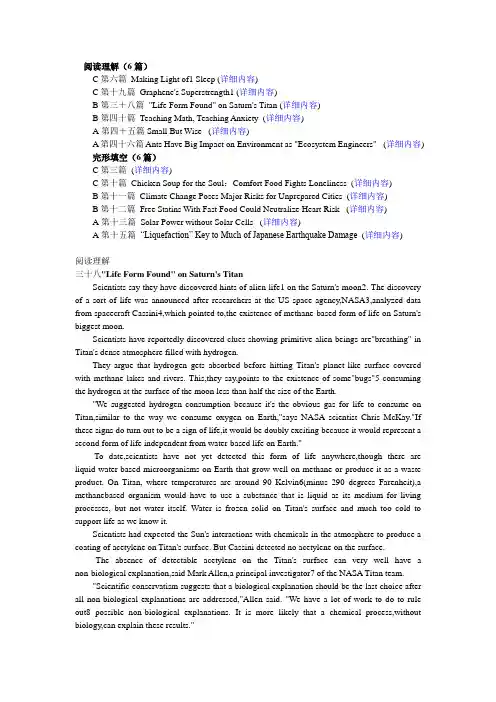
阅读理解(6篇)C第六篇Making Light of1 Sleep (详细内容)C第十九篇Graphene's Superstrength1 (详细内容)B第三+八篇"Life Form Found" on Saturn's Titan (详细内容)B第四十篇Teaching Math, Teaching Anxiety (详细内容)A第四+五篇Small But Wise (详细内容)A第四十六篇Ants Have Big Impact on Environment as "Ecosystem Engineers" (详细内容) 完形填空(6篇)C第三篇 (详细内容)C第十篇Chicken Soup for the Soul:Comfort Food Fights Loneliness (详细内容)B第十一篇Climate Change Poses Major Risks for Unprepared Cities (详细内容)B第十二篇Free Statins With Fast Food Could Neutralize Heart Risk (详细内容)A第十三篇Solar Power without Solar Cells (详细内容)A第十五篇“Liquefaction” Key to Much of Japanese Earthquake Damage (详细内容)阅读理解三十八"Life Form Found" on Saturn's TitanScientists say they have discovered hints of alien life1 on the Saturn's moon2. The discovery of a sort of life was announced after researchers at the US space agency,NASA3,analyzed data from spacecraft Cassini4,which pointed to,the existence of methane-based form of life on Saturn's biggest moon.Scientists have reportedly discovered clues showing primitive alien beings are"breathing" in Titan's dense atmosphere filled with hydrogen.They argue that hydrogen gets absorbed before hitting Titan's planet-like surface covered with methane lakes and rivers. This,they say,points to the existence of some"bugs"5 consuming the hydrogen at the surface of the moon less than half the size of the Earth."We suggested hydrogen consumption because it's the obvious gas for life to consume on Titan,similar to the way we consume oxygen on Earth,"says NASA scientist Chris McKay."If these signs do turn out to be a sign of life,it would be doubly exciting because it would represent a second form of life independent from water-based life on Earth."To date,scientists have not yet detected this form of life anywhere,though there are liquid-water-based microorganisms on Earth that grow well on methane or produce it as a waste product. On Titan, where temperatures are around 90 Kelvin6(minus 290 degrees Farenheit),a methanebased organism would have to use a substance that is liquid as its medium for living processes, but not water itself. Water is frozen solid on Titan's surface and much too cold to support life as we know it.Scientists had expected the Sun's interactions with chemicals in the atmosphere to produce a coating of acetylene on Titan's surface. But Cassini detected no acetylene on the surface.The absence of detectable acetylene on the Titan's surface can very well have a non-biological explanation,said Mark Allen,a principal investigator7 of the NASA Titan team."Scientific conservatism suggests that a biological explanation should be the last choice after all non-biological explanations are addressed,"Allen said. "We have a lot of work to do to rule out8 possible non-biological explanations. It is more likely that a chemical process,without biology,can explain these results."词汇:Saturn n.土星methane n.甲烷,沼气Titan n.土卫六acetylene n.乙炔alien n.外星人;adj.外星球的;相异的conservatism n.保守主义,守旧注释:1.hints of alien life:外星生命迹象。
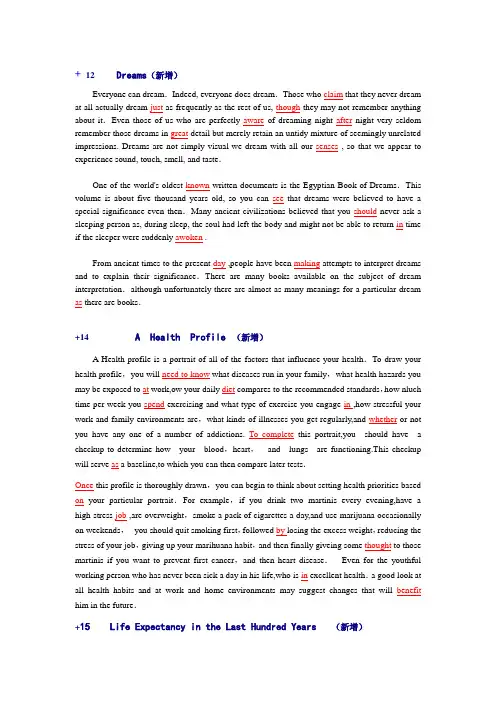
+12 Dreams(新增)Everyone can dream.Indeed, everyone does dream.Those who claim that they never dream at all actually dream just as frequently as the rest of us, though they may not remember anything about it.Even those of us who are perfectly aware of dreaming night after night very seldom remember those dreams in great detail but merely retain an untidy mixture of seemingly unrelated impressions. Dreams are not simply visual-we dream with all our senses , so that we appear to experience sound, touch, smell, and taste.One of the world's oldest known written documents is the Egyptian Book of Dreams.This volume is about five thousand years old, so you can see that dreams were believed to have a special significance even then.Many ancient civilizations believed that you should never ask a sleeping person as, during sleep, the soul had left the body and might not be able to return in time if the sleeper were suddenly awoken .From ancient times to the present day ,people have been making attempts to interpret dreams and to explain their significance.There are many books available on the subject of dream interpretation.although unfortunately there are almost as many meanings for a particular dream as there are books.+14 A Health Profile (新增)A Health profile is a portrait of all of the factors that influence your health.To draw your health profile,you will need to know what diseases run in your family,what health hazards you may be exposed to at work,ow your daily diet compares to the recommended standards,how nluch time per week you spend exercising and what type of exercise you engage in ,how stressful your work and family environments are,what kinds of illnesses you get regularly,and whether or not you have any one of a number of addictions. To complete this portrait,you should have a checkup to determine how your blood,heart,and lungs are functioning.This checkup will serve as a baseline,to which you can then compare later tests.Once this profile is thoroughly drawn,you can begin to think about setting health priorities based on your particular portrait.For example,if you drink two martinis every evening,have a high-stress job ,are overweight,smoke a pack of cigarettes a day,and use marijuana occasionally on weekends,you should quit smoking first,followed by losing the excess weight,reducing the stress of your job,giving up your marihuana habit,and then finally giveing some thought to those martinis if you want to prevent first cancer,and then heart disease.Even for the youthful working person who has never been sick a day in his life,who is in excellent health.a good look at all health habits and at work and home environments may suggest changes that will benefit him in the future.+15 Life Expectancy in the Last Hundred Years (新增)A hundred years ago,life expectancy in developed countries was about 47: in the early 21st century, men in the United States and the United Kingdom can expect to live to about 74. Women to about 80, and these ages are rising all the time. What has brought about these changes? When we look at the life span of people l00 years ago, we need to look at the greatest killers of the time. In the early 20th century, these were the acute and often highly infectious diseases such as smallpox. Many children died very young from these diseases and others, and the weak and elderly were always at risk.In the developed world these diseases are far lessdeadly today, and in some cases have almost disappeared. A number of factors shave led to this: improvements in sanitation and hygiene, the discovery and use of antibiotics, which make bacterial diseases much less dangerous, and vaccinations against common diseases. In addition, people's general health has improved with improvements in our general environment: cleaner air, better means of preserving food,better and warmer housing,and better understanding of nutrition.Genetically,we should all be able to live to about 85 but while people do live longer today, there are still some big killers around that are preventing US from consistently reaching that age. The problems that affect people today are the more chronic illnesses, such as heart disease and strokes, and those spread by viruses, such as influenza and AIDS l. Of course, cancer is a huge killer as well. In most cases these diseases affect older people, but there are worrying trends in the developed world with problems such as obesity leadingto more heart disease and illnesses such as diabetes at younger ages.The killers today can be classed as "lifestyle diseases",which means that it may be possible to halt their progress.第三十四篇谁想永生?如果你的医生能给你一种药,这个药能让你健康的活两倍长的时间,你会服用吗?好消息是我们离这一天越来越近了。
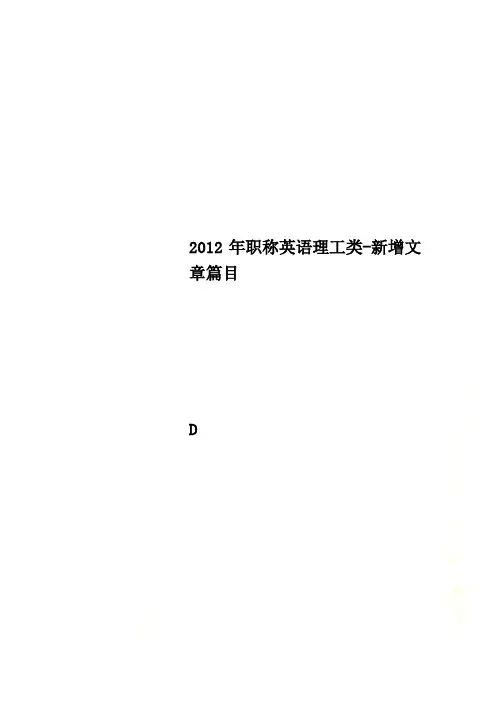
2012年职称英语理工类-新增文章篇目D2012年职称英语理工类新增文章篇目阅读理解(6篇)……………………3页第六篇Making Light of1 Sleep第十九篇Graphene's Superstrength1*第三+八篇"Life Form Found" on Saturn's Titan*第四十篇Teaching Math, Teaching Anxiety +第四+五篇Teaching Math, Teaching Anxiety +第四十六篇Ants Have Big Impact on Environment as "Ecosystem Engineers"完形填空(6篇)……………………20页第三篇Germs on Banknotes第十篇Chicken Soup for the Soul:Comfort Food Fights Loneliness*第十一篇Climate Change Poses Major Risks for Unprepared Cities*第十二篇Free Statins With Fast Food Could Neutralize Heart Risk+第十三篇Solar Power without Solar Cells +第十五篇“Liquefaction” Key to Much of Japanese Earthquake DamageThey argue that hydrogen gets absorbed before hitting Titan's planet-like surface covered with methane lakes and rivers. This,they say,points to the existence of some"bugs"5 consuming the hydrogen at the surface of the moon less than half the size of the Earth."We suggested hydrogen consumption because it's the obvious gas for life to consume on Titan,similar to the way we consume oxygen on Earth,"says NASA scientist Chris McKay."If these signs do turn out to be a sign of life,it would be doubly exciting because it would represent a second form of life independent from water-based life on Earth."To date,scientists have not yet detected this form of life anywhere,though there are liquid-water-based microorganisms on Earth that grow well on methane or produce it as a waste product. On Titan, where temperatures are around 90 Kelvin6(minus 290 degreesFarenheit),a methanebased organism would have to use a substance that is liquid as its medium for living processes, but not water itself. Water is frozen solid on Titan's surface and much too cold to support life as we know it.Scientists had expected the Sun's interactions with chemicals in the atmosphere to produce a coating of acetylene on Titan's surface. But Cassini detected no acetylene on the surface.The absence of detectable acetylene on the Titan's surface can very well have a non-biological explanation,said Mark Allen,a principal investigator7of the NASA Titan team."Scientific conservatism suggests that a biological explanation should be the last choice after all non-biological explanations are addressed,"Allen said. "We have a lot of work to do to rule out8 possible non-biological explanations. It is more likely that a chemical process,without biology,can explain theseresults."词汇:Saturn /'sætən/ n.土星methane/'mi:θein/ n.甲烷,沼气Titan/'taitən/ n.土卫六acetylene/ə'setili:n/ n.乙炔alien/'eiljən/ n.外星人;adj.外星球的;相异的conservatism/kən'sʒ:vətizəm/ n.保守主义,守旧注释:1.hints of alien life:外星生命迹象。
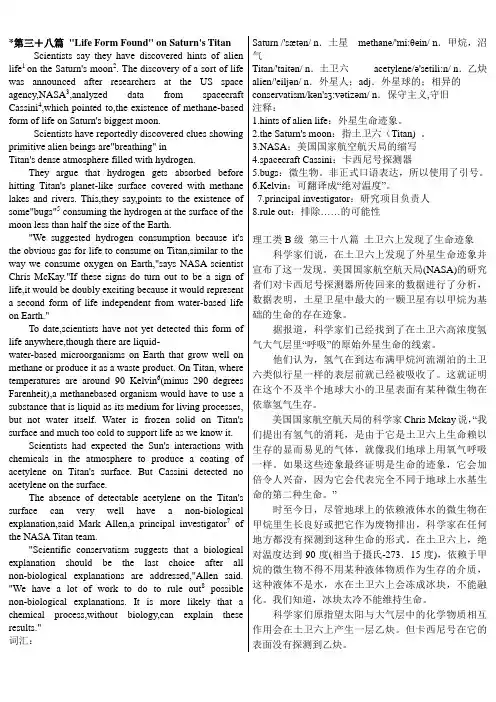
*第三+八篇"Life Form Found" on Saturn's Titan Scientists say they have discovered hints of alien life1 on the Saturn's moon2. The discovery of a sort of life was announced after researchers at the US space agency,NASA3,analyzed data from spacecraft Cassini4,which pointed to,the existence of methane-based form of life on Saturn's biggest moon.Scientists have reportedly discovered clues showing primitive alien beings are"breathing" inTitan's dense atmosphere filled with hydrogen.They argue that hydrogen gets absorbed before hitting Titan's planet-like surface covered with methane lakes and rivers. This,they say,points to the existence of some"bugs"5 consuming the hydrogen at the surface of the moon less than half the size of the Earth."We suggested hydrogen consumption because it's the obvious gas for life to consume on Titan,similar to the way we consume oxygen on Earth,"says NASA scientist Chris McKay."If these signs do turn out to be a sign of life,it would be doubly exciting because it would represent a second form of life independent from water-based life on Earth."To date,scientists have not yet detected this form of life anywhere,though there are liquid-water-based microorganisms on Earth that grow well on methane or produce it as a waste product. On Titan, where temperatures are around 90 Kelvin6(minus 290 degrees Farenheit),a methanebased organism would have to use a substance that is liquid as its medium for living processes, but not water itself. Water is frozen solid on Titan's surface and much too cold to support life as we know it.Scientists had expected the Sun's interactions with chemicals in the atmosphere to produce a coating of acetylene on Titan's surface. But Cassini detected no acetylene on the surface.The absence of detectable acetylene on the Titan's surface can very well have a non-biological explanation,said Mark Allen,a principal investigator7of the NASA Titan team."Scientific conservatism suggests that a biological explanation should be the last choice after all non-biological explanations are addressed,"Allen said. "We have a lot of work to do to rule out8possible non-biological explanations. It is more likely that a chemical process,without biology,can explain these results."词汇:Saturn /'sætən/ n.土星methane/'mi:θein/ n.甲烷,沼气Titan/'taitən/ n.土卫六acetylene/ə'setili:n/ n.乙炔alien/'eiljən/ n.外星人;adj.外星球的;相异的conservatism/kən'sʒ:vətizəm/ n.保守主义,守旧注释:1.hints of alien life:外星生命迹象。
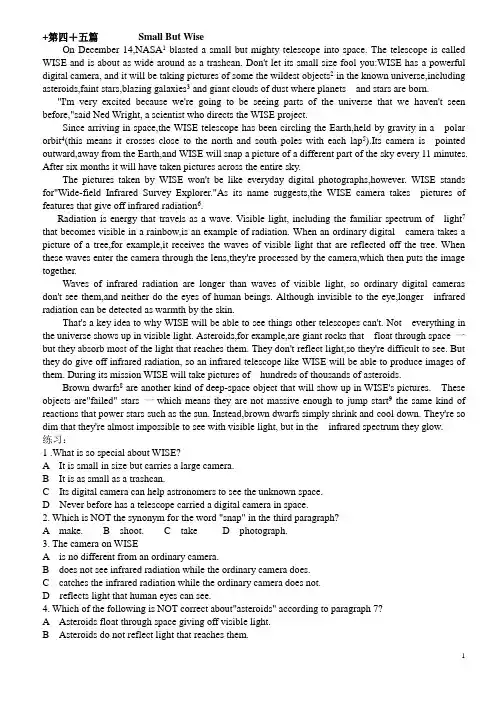
+第四+五篇Small But WiseOn December 14,NASA1 blasted a small but mighty telescope into space. The telescope is called WISE and is about as wide around as a trashcan. Don't let its small size fool you:WISE has a powerful digital camera, and it will be taking pictures of some the wildest objects2 in the known universe,including asteroids,faint stars,blazing galaxies3 and giant clouds of dust where planets and stars are born."I'm very excited because we're going to be seeing parts of the universe that we haven't seen before,"said Ned Wright, a scientist who directs the WISE project.Since arriving in space,the WISE telescope has been circling the Earth,held by gravity in a polar orbit4(this means it crosses close to the north and south poles with each lap5).Its camera is pointed outward,away from the Earth,and WISE will snap a picture of a different part of the sky every 11 minutes. After six months it will have taken pictures across the entire sky.The pictures taken by WISE won't be like everyday digital photographs,however. WISE stands for"Wide-field Infrared Survey Explorer."As its name suggests,the WISE camera takes pictures of features that give off infrared radiation6.Radiation is energy that travels as a wave. Visible light, including the familiar spectrum of light7 that becomes visible in a rainbow,is an example of radiation. When an ordinary digital camera takes a picture of a tree,for example,it receives the waves of visible light that are reflected off the tree. When these waves enter the camera through the lens,they're processed by the camera,which then puts the image together.Waves of infrared radiation are longer than waves of visible light, so ordinary digital cameras don't see them,and neither do the eyes of human beings. Although invisible to the eye,longer infrared radiation can be detected as warmth by the skin.That's a key idea to why WISE will be able to see things other telescopes can't. Not everything in the universe shows up in visible light. Asteroids,for example,are giant rocks that float through space 一but they absorb most of the light that reaches them. They don't reflect light,so they're difficult to see. But they do give off infrared radiation, so an infrared telescope like WISE will be able to produce images of them. During its mission WISE will take pictures of hundreds of thousands of asteroids.Brown dwarfs8 are another kind of deep-space object that will show up in WISE's pictures. These objects are"failed" stars 一which means they are not massive enough to jump start9 the same kind of reactions that power stars such as the sun. Instead,brown dwarfs simply shrink and cool down. They're so dim that they're almost impossible to see with visible light, but in the infrared spectrum they glow.练习:1 .What is so special about WISE?A It is small in size but carries a large camera.B It is as small as a trashcan.C Its digital camera can help astronomers to see the unknown space.D Never before has a telescope carried a digital camera in space.2. Which is NOT the synonym for the word "snap" in the third paragraph?A make.B shoot.C takeD photograph.3. The camera on WISEA is no different from an ordinary camera.B does not see infrared radiation while the ordinary camera does.C catches the infrared radiation while the ordinary camera does not.D reflects light that human eyes can see.4. Which of the following is NOT correct about"asteroids" according to paragraph 7?A Asteroids float through space giving off visible light.B Asteroids do not reflect light that reaches them.C It is difficult to take asteroids' pictures by ordinary cameras,D The WISE telescope can take pictures of asteroids5.What is implied in the last paragraph?A Brown dwarfs give off visible light.B Brown dwarfs give off infrared radiation.C Brown dwarfs are power stars like the sun.D Brown dwarfs are impossible to see with the WISE telescope.答案与题解:1. C 短文的第一和第二段提供了答案。
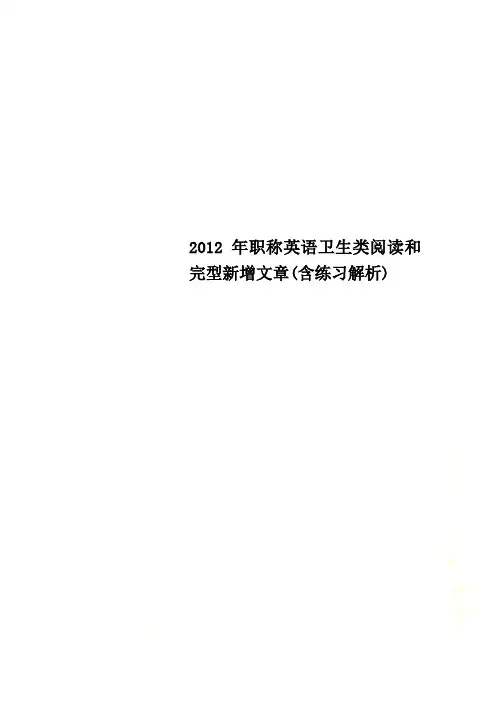
2012年职称英语卫生类阅读和完型新增文章(含练习解析)2012年职称英语卫生类新增文章篇目2012年职称英语理工、综合和卫生教材(电子版已经发布,欢迎下载)阅读理解(5篇)第八篇 Eat Healthy (2011年综合类第一篇)第十九篇Prolonging Human Life (2011理工类第十九篇)*第二十四篇Sleep Lets Brain File Memories(2011年理工类第二十八篇;综合类第二十篇)+第三十四篇Who Want to Live Forever? (2011年综合类第三十一篇)+第四十篇 Some People Do Not Taste Salt Like Others(2011年理工类第四十五篇)完形填空(5篇)第二篇Going on a diet 已有*第八篇 Old And Active已有+第十二篇 Dreams已有+第十四篇 A Health Profile (2009年综合类教材)+第十五篇 Life Expectancy in the Last Hundred Years(2011综合类教材)注:1、+表示A级文章;*表示B即文章;其他为C级文章;2、完形填空,请参见第18页;3、2012年词汇部分与2011年教材相比未作任何变化。
阅读理解第八篇 Eat Healthy"Clean your plate!" and "Be a member of the clean-plate -club!" Just about every kid in the US has heard this from a parent or grandparent. Often,it's accompanied by an appeal:" Just think about those starving orphans in Africa!" Sure, we should be grateful for every bite of food. Unfortunately, many people in the US take too many bites. Instead of staying "clean the plate", perhaps we should save some food for tomorrow.According to news reports, US restaurants are partly to blame for the growing bellies. A waiter puts a plate of food in front of each customer, with two to four times the amount recommended by the government, according to a USA Today story. Americans traditionally associate quantity with value and most restaurants try to give them that. They prefer to have customers complain about too much food rather than too little.Barbara Rolls, a nutrition professor at Pennsylvania State University, told USA Today that restaurant portion sizes began to grow in the 1970s, the same time that the American waistline began to expand.Health experts have tried to get many restaurants to serve smaller portions. Now, apparently,some customers are calling for this too. The restaurant industry trade magazine QSR reported last month that 57 percent of more than 4,000 people surveyed believe restaurants serve portions that are too large; 23 percent had no opinion; 20 percent disagreed. But a closer look at the survey indicates that many Americans who can't afford fine dining still prefer large portions. Seventy percent of those earning at least $150,000 per year prefer smaller portions; but only 45 percent of those earning less than $25,000 want smaller.It's not that working class Americans don't want to eat healthy. It's just that,after long hours at low-paying jobs,getting less on their plate hardly seems like a good deal. They live from paycheck to paycheck ,happy to save a little money for next year's Christmas presents.词汇:orphan /''?:f?n] / n.孤儿belly /'beli/ n.肚子nutrition / nju:'tri??n / n.营养waistline / 'weistlain / n.腰围paycheck / 'pei't?ek / n.薪金支票注释:1. Be a member of the clean - plate club! 做清盘俱乐部的成员2. Just think about those starving orphans in Africa! 只要想想在非洲挨饿的孤儿们!3. take too many bites 吃得太多4. A Waiter puts a plate of food in front of each customer,with two to four times the amount recommended by the government, according to a USA Today story. 根据《今日美国》刊登的一个故事,服务员给每个顾客一盘饭菜,其量是政府推荐的2至4倍。
Making Light of Sleep不要太在意睡眠我们每个人的大脑里都有一个像我们床边的闹钟一样的生物钟。
人脑里的生物钟24小时走一圈,这一圈也就是一次完整的昼夜节律,正是这个节律决定了我们吃饭、睡觉和起床的时间。
青春期时,人的生物钟在定时方面会发生变化,生物钟会提前。
这时,青少年会比以前睡得晚,所以当你妈妈告诉你该睡觉时,你的生物钟可能会让你多推迟几小时,并且电脑或电视光线可能会导致你熬夜到更晚。
生物钟的这种变化对青少年说是正常的,但熬夜到太晚会打乱你生物钟与昼夜时间循环之间的平衡,这样就会带来一些问题,例如:早晨很难按时起床。
位于美国罗得州布郎大学睡眠方面的研究员Mary Carskadon说:“当青少年睡眠不足时会打不起精神,这将影响到他们心情、学习和思考问题的状态。
”其实生物钟与闹钟一样,也是可调的,事实上,生物钟每天都在进行着自我调节,其方式就是通过你眼睛接收到光线的变化。
很早之前,科学家就知道了昼夜光线强弱的变化对生物钟调节起到了重要的作用,长久以来,研究者们认为眼睛所接受到的平衡生物钟的光信号同样作用于人类的视觉系统。
但最近几年的研究发现,人类眼睛有两个感光系统,一个是视觉系统,而另一个是感知昼夜的系统。
Graphene's Superstrength 石墨烯的超强力量当今重大科学技术均以“微型”来呈现,新手机和个人电脑每年都在变得更小,这就意味着电子设备要求内部零件更小,工程师们正在寻求制造这些零件的方法,他们逐渐把目光投向了石墨烯——一种由碳元素构成的超薄材料。
这种材料将改变电子设备的未来。
今年的诺贝尔物理学奖颁发给了来自英国曼切斯特大学的Andre Geim和Kostya Novoselov,以表彰他们对石墨烯的发现。
Novoselov说:“石墨烯不仅小,而且它是世界上所能找到的最薄材料。
”他把它称作“神奇材料”。
石墨烯极薄,25 000片石墨烯叠放在一起才与一张普通白纸一样厚。
2012年重点阅读理解及完形填空文章第一部分:阅读理解 ...........................................................................................................................理工类C级 ..................................................................................................................................第六篇Making Light of1 Sleep【不要太在意睡眠】 .........................................................第十九篇Graphene's Superstrength【石墨烯的超强力量】 ............................................理工类B级 ..................................................................................................................................*第三十八篇“Life Form Found” on Saturn's Titan【土卫六上发现了生命迹象】 ...........*第四十篇Teaching Math, Teaching Anxiety【教数学,教焦虑】 ...................................理工类A级 ..................................................................................................................................+第四十五篇 Small But Wise【小而聪明】 ....................................................................+第四十六篇Ants Have Big Impact on Environment as “Ecosystem Engineers”【 蚂蚁作为“生态系统工程师”对环境影响巨大】 ........................................................................ 第二部分:完形填空 ...........................................................................................................................理工类C级 ..................................................................................................................................第三篇Germs on Banknotes【纸币上的病菌】 ................................................................第十篇Chicken Soup for the Soul: Comfort Food Fights Loneliness【心灵鸡汤:爽心食品排解孤独感】 ...................................................................................................................理工类B级 ..................................................................................................................................*第十一篇Climate Change Poses Major Risks for Unprepared Cities【气候变化给不备城市带来重大风险】 ...........................................................................................................*第十二篇Free Statins With Fast Food Could Neutralize Heart Risk【快餐加免费降胆固醇药物可以降低罹患心脏病的风险】 ...........................................................................理工类A级 ..................................................................................................................................+第十三篇Solar Power without Solar Cells【没有太阳能电池的太阳能】 ......................+第十五篇“Liquefaction” Key to Much of Japanese Earthquake Damage【“液化”是日本地震破坏的关键】 ...............................................................................................................第四部分阅读理解理工类C级第六篇Making Light of1 Sleep【不要太在意睡眠】All we have a clock located inside our brains. Similar to your bedside alarm clock, your internal clock2 runs on a 24-hour cycle. This cycle, called a circadian rhythm, helps control when you wake, when you eat and when you sleep.Somewhere around puberty, something happens in the timing of the biological clock. The clock pushes forward, so adolescents and teenagers are unable to fall asleep as early as they used to. When your mother tells you it's time for bed, your body may be pushing you to stay up3 for several hours more. And the light coming from your computer screen or TV could be pushing you to stay up even later.This shift4 is natural for teenagers. But staying up very late and sleeping late can get your body's clock out of sync with the cycle of light and dark5. It can also make it hard to get out of bed in the morning and may bring other problems, too. Teenagers are put in a kind of a gray cloud6when they don't get enough sleep, says Mary Carskadon, a sleep researcher at Brown University in Providence, RI7. It affects their mood and their ability to think and learn.But just like your alarm clock, your internal clock can be reset. In fact, it automatically resets itself every day. How? By using the light it gets through your eyes.Scientists have known for a long time that the light of day and the dark of night play important roles in setting our internal clocks. For years, researchers thought that the signals that synchronize the body's clock8 were handled through the same pathways that we use to see.But recent discoveries show that the human eye has two separate light-sensing systems. One system allows us to see. The second system tells our body whether it's day or night.练习:1. The clock located inside our brains is similar to our bedside alarm clock becauseA it controls when we wake, when we eat and when we sleep.B it has a cycle of 24 hours.C it is a cycle also called circadian rhythm.D it can alarm any time during 24 hours.2. What is implied in the second paragraph?A Young children's biological clock has the same rhythm with that of the teenagers.B People after puberty begin to go to bed earlier due to the change of the biological clock.C Children before puberty tend to fall asleep earlier at night than adolescents.D Teenagers go to bed later than they used to due to the light from the computer screen.3. In the third paragraph the author wants to tell the reader thatA it is natural for teenagers to stay up late and get up late.B staying up late has a bad effect on teenagers' ability to think and learn.C during puberty most teenagers experience a kind of gray cloud.D it is hard for teenagers to get out of bed in the morning.4. Which of the following statements is NOT true according to the fourth and fifthparagraphs?A Our biological clock resets itself automatically.B light gets through our eyes and resets our biological clock.C Our internal clock as well as the alarm clock can be reset automatically.D Our internal clock, like the alarm clock, can be reset.5. According to the last two paragraphs, what did the previous researchers think about the human eye's light-sensing system?A The human eye had two light-sensing systems.B The human eye had one light-sensing system.C The human eye could sense the light of day more quickly than the dark of night.D The human eye could reset our internal clocks in accordance with the alarm clocks.答案1. B2. C3. B4. C5. B第六篇不要太在意睡眠我们每个人的大脑里都有一个像我们床边的闹钟一样的生物钟。
2012 年重点阅读理解及完形填空文章第一部分:阅读理解...........................................................................................................................理工类C 级................................................................................................................................. 第六篇Making Light of1 Sleep【不要太在意睡眠】.........................................................第十九篇Graphene's Superstrength【石墨烯的超强力量】............................................理工类B 级................................................................................................................................. *第三十八篇“Life Form Found” on Saturn's Titan【土卫六上发现了生命迹象】...........*第四十篇Teaching Math, Teaching Anxiety【教数学,教焦虑】...................................理工类A 级................................................................................................................................. +第四十五篇Small But Wise【小而聪明】....................................................................+第四十六篇Ants Have Big Impact on Enviro nment as “Ecosystem Engineers”【蚂蚁作为“生态系统工程师”对环境影响巨大】........................................................................第二部分:完形填空...........................................................................................................................理工类C 级................................................................................................................................. 第三篇Germs on Banknotes【纸币上的病菌】................................................................第十篇Chicken Soup for the Soul: Comfort Food Fights Loneliness【心灵鸡汤:爽心食品排解孤独感】...................................................................................................................理工类B 级................................................................................................................................. *第十一篇Climate Change Poses Major Risks for Unprepared Cities【气候变化给不备城市带来重大风险】...........................................................................................................*第十二篇Free Statins With Fast Food Could Neutralize Heart Risk【快餐加免费降胆固醇药物可以降低罹患心脏病的风险】...........................................................................理工类A 级................................................................................................................................. +第十三篇Solar Power without Solar Cells【没有太阳能电池的太阳能】......................+第十五篇“Liquefaction” Key to Much of Japanese Earthquake Damage【“液化”是日本地震破坏的关键】...............................................................................................................第四部分阅读理解理工类C 级第六篇Making Light of1 Sleep【不要太在意睡眠】All we have a clock located inside our brains. Similar to your bedside alarm clock, yourinternal clock2 runs on a 24-hour cycle. This cycle, called a circadian rhythm, helps control when you wake, when you eat and when you sleep.Somewhere around puberty, something happens in the timing of the biological clock. Theclock pushes forward, so adolescents and teenagers are unable to fall asleep as early as they used to. When your mother tells you it's time for bed, your body may be pushing you to stay up3 for several hours more. And the light coming from your computer screen or TV could be pushing you to stay up even later.This shift4 is natural for teenagers. But staying up very late and sleeping late can get yourbody's clock out of sync with the cycle of light and dark5. It can also make it hard to get out of bed in the morning and may bring other problems, too. Teenagers are put in a kind of a gray cloud6when they don't get enough sleep, says Mary Carskadon, a sleep researcher at Brown University in Providence, RI7. It affects their mood and their ability to think and learn.But just like your alarm clock, your internal clock can be reset. In fact, it automatically resets itself every day. How? By using the light it gets through your eyes.Scientists have known for a long time that the light of day and the dark of night playimportant roles in setting our internal clocks. For years, researchers thought that the signals that synchronize the body's clock8 were handled through the same pathways that we use to see.But recent discoveries show that the human eye has two separate light-sensing systems. One system allows us to see. The second system tells our body whether it's day or night.练习:1. The clock located inside our brains is similar to our bedside alarm clock becauseA it controls when we wake, when we eat and when we sleep.B it has a cycle of 24 hours.C it is a cycle also called circadian rhythm.D it can alarm any time during 24 hours.2. What is implied in the second paragraph?A Young children's biological clock has the same rhythm with that of the teenagers.B People after puberty begin to go to bed earlier due to the change of the biological clock.C Children before puberty tend to fall asleep earlier at night than adolescents.D Teenagers go to bed later than they used to due to the light from the computer screen.3. In the third paragraph the author wants to tell the reader thatA it is natural for teenagers to stay up late and get up late.B staying up late has a bad effect on teenagers' ability to think and learn.C during puberty most teenagers experience a kind of gray cloud.D it is hard for teenagers to get out of bed in the morning.4. Which of the following statements is NOT true according to the fourth and fifth paragraphs?A Our biological clock resets itself automatically.B light gets through our eyes and resets our biological clock.C Our internal clock as well as the alarm clock can be reset automatically.D Our internal clock, like the alarm clock, can be reset.5. According to the last two paragraphs, what did the previous researchers think about the human eye's light-sensing system?A The human eye had two light-sensing systems.B The human eye had one light-sensing system.C The human eye could sense the light of day more quickly than the dark of night.D The human eye could reset our internal clocks in accordance with the alarm clocks.答案1. B2. C3. B4. C5. B第六篇不要太在意睡眠我们每个人的大脑里都有一个像我们床边的闹钟一样的生物钟。
阅读理解+第四+五篇 Small But WiseOn December 14,NASA1 blasted a small but mighty telescope into space. The telescope iscalled WISE and is about as wide around as a trashcan. Don't let its small size fool you:WISE hasa powerful digital camera, and it will be taking pictures of some the wildest objects2 in the known universe,including asteroids,faint stars,blazing galaxies3 and giant clouds of dust where planetsand stars are born."I'm very excited because we're going to be seeing parts of the universe that we haven't seen before,"said Ned Wright, a scientist who directs the WISE project.Since arriving in space,the WISE telescope has been circling the Earth,held by gravity in apolar orbit4(this means it crosses close to the north and south poles with each lap5).Its camera is pointed outward,away from the Earth,and WISE will snap a picture of a different part of the skyevery 11 minutes. After six months it will have taken pictures across the entire sky.The pictures taken by WISE won't be like everyday digital photographs,however. WISEstands for"Wide-field Infrared Survey Explorer."As its name suggests,the WISE camera takespictures of features that give off infrared radiation6.Radiation is energy that travels as a wave. Visible light, including the familiar spectrum oflight7 that becomes visible in a rainbow,is an example of radiation. When an ordinary digitalcamera takes a picture of a tree,for example,it receives the waves of visible light that are reflected off the tree. When these waves enter the camera through the lens,they're processed by the camera,which then puts the image together.Waves of infrared radiation are longer than waves of visible light, so ordinary digital cameras don't see them,and neither do the eyes of human beings. Although invisible to the eye,longerinfrared radiation can be detected as warmth by the skin.That's a key idea to why WISE will be able to see things other telescopes can't. Noteverything in the universe shows up in visible light. Asteroids,for example,are giant rocks thatfloat through space 一but they absorb most of the light that reaches them. They don't reflect light,so they're difficult to see. But they do give off infrared radiation, so an infrared telescope like WISE will be able to produce images of them. During its mission WISE will take pictures ofhundreds of thousands of asteroids.Brown dwarfs8 are another kind of deep-space object that will show up in WISE's pictures.These objects are"failed" stars 一which means they are not massive enough to jump start9 thesame kind of reactions that power stars such as the sun. Instead,brown dwarfs simply shrink andcool down. They're so dim that they're almost impossible to see with visible light, but in theinfrared spectrum they glow.练习:1 .What is so special about WISE?A It is small in size but carries a large camera.B It is as small as a trashcan.C Its digital camera can help astronomers to see the unknown space.D Never before has a telescope carried a digital camera in space.2. Which is NOT the synonym for the word "snap" in the third paragraph?A make.B shoot.C takeD photograph.3. The camera on WISEA is no different from an ordinary camera.B does not see infrared radiation while the ordinary camera does.C catches the infrared radiation while the ordinary camera does not.D reflects light that human eyes can see.4. Which of the following is NOT correct about"asteroids" according to paragraph 7?A Asteroids float through space giving off visible light.B Asteroids do not reflect light that reaches them.C It is difficult to take asteroids' pictures by ordinary cameras,D The WISE telescope can take pictures of asteroids5.What is implied in the last paragraph?A Brown dwarfs give off visible light.B Brown dwarfs give off infrared radiation.C Brown dwarfs are power stars like the sun.D Brown dwarfs are impossible to see with the WISE telescope.答案与题解:1. C 短文的第一和第二段提供了答案。
*第十一篇 Climate Change Poses Major Risks for Unprepared CitiesA new examination of urban policies has been 1 recently by Patricia Romero Lankao.She is a sociologist specializing in climate change and 2 development.She warns that many o f the world’s fast-growing urban areas,especially in developing countries.will likely suffer from the impacts of changing climate.Her work also concludes that most cities are failing to 3 emissions of carbon dioxide and other greenhouse 4 .These gases are known to affect the atmosphere.”Climate change is a deeply local issue and poses profound threats to the growing cities of the world,” says Romero Lankao. ”But too few cities are developing effective strategies to 5 their residents."Cities are 6 sources of greenhouse gases.And urban populations are likely to be among those most severely affected by future climate change. Lankao’s findings highlight ways in which city-residents are particularly vulnerable, and suggest policy interventions that could offer immediate and longer-term 7 .The locations and dense construction patterns of cities often place their populations at greater risk for natural disasters. Potential 8 associated with climate include storm surges and prolonged hot weather. Storm surges can flood coastal areas and prolonged hot weather can heat 9 paved cities more than surrounding areas.The impacts of such natural events can be more serious in an urban environment.For example,a prolonged heat wave can increase existing levels of air pollution,causing widespread health problems.Poorer neighborhoods that may 10 basic facilities such as drinking water or a dependable network of roads,are especially vulnerable to natural disasters.Many residents in poorer countries live in substandard housing 11 access to reliable drinking water,roads and basic services.Local governments, 12 ,should take measures to protect their residents.”Unfortunately,they tend to move towards rhetoric 13 meaningful responses, Romero Lankao writes, ” They don’t impose construction standards that could reduce heating and air conditioning needs. They don't emphasize mass transit and reduce 14 use. In fact, many local governments are taking a hands—off approach.” Thus, she urges them to change their 15 policies and to take strong steps to prevent the harmful effects of climate change on cities.词汇:vulnerable / 'vʌlnərəbl / adj .易受伤害的infrastructure / 'infrə,strʌktʃə/ n .基础设施sociologist /,səusi'ɔlədʒist /n.社会学家substandard / ,sʌb'stændəd / adj.标准以下的dioxide / dai'ɔksaid / .二氧化物floodplain /'flʌdplein / n .泛滥平原注释:1. likely:很可能,或许。
完形填空(6篇)第三篇Germs on Banknotes第十篇 Chicken Soup for the Soul:Comfort Food Fights Loneliness*第十一篇Climate Change Poses Major Risks for Unprepared Cities*第十二篇Free Statins With Fast Food Could Neutralize Heart Risk+第十三篇 Solar Power without Solar Cells+第十五篇“Liquefaction” Key to Much of Japanese Earthquake Damage注:1、+表示A级文章;*表示B即文章;其他为C级文章2、阅读理解3、2012年词汇部分与2011年教材相比未作任何变化第三篇Germs on BanknotesPeople in different countries use different types of 1 yuan in China, pesos in Mexico, pounds in the United Kingdom, dollars in the United States, Australia and New Zealand. They may use 2 currencies, but these countries, and probably all countries, still have one thing in common1: Germs on the banknotes.Scientists have been studying the germs on money for well over2 100 years. At the turn of the 20th 3 , some researchers began to suspect that germs living on money could spread disease.Most studies of germy money have looked at the germs on the currency 4 one country. In a new study, Frank Vriesekoop3 and other researchers compared the germ populations found on bills of different 5 .Vriesekoop3 is a microbiologist at the University of Ballarat in Australia4. He led the study, which compared the germ populations found on money 6 from 10 nations. The scientists studied 1,280 banknotes in total; all came from places where people buy food, like supermarkets street vendors and cafes, 7 those businesses often rely on cash.Overall, the Australian dollars hosted the fewest live bacteria ---- no more than 10 per square centimeter. Chinese yuan had the most ---- about 100 per square centimeter. Most of the germs on money probably would not cause harm.What we call “paper” money usually isn't made from paper. The U. S. dollar, for example, is printed on fabric that is mostly 8 .Different countries may use different 9 to print their money. Some of the currencies studied by Vriesekoop and his 10 such as the American dollar were made from cotton. Others were made from polymers.The three 11 with the lowest numbers of bacteria were all printed on polymers. They included the Australian dollar, the New Zealand dollar and some Mexican pesos.The other currencies were printed on fabric made 12 of cotton. Fewergerms lived on the polymer notes. This connection suggests that 13 have a harder time staying alive on polymer surfaces. Scientists need to do more studies to understand how germs live on money-----and whether or not we need to be concerned. Vnesekoop is now starting a study that will 14 the amounts of time bacteria can stay alive on different types of bills.Whatever Vriesekoop finds, the fact remains: Paper money harbors germs We should wash our 15 after touching it; after all5, you never know where your money 's been. Or what's living on it词汇:pesos/pi:səvs/ n .比索bacterium /kæk'tiəriəm/ n .细菌(单数)germ/də:m/ n.病菌bacteria /bæktiəriə/细菌(复数)banknote/bæŋknəvt/ n.纸币centimeter/senti,mi:tə。
/ n.厘米microbiologist /,maikrəv,bai ləd ist/n.微生polymer/p limə / n. [高分子」聚合物物学家harbor/ha:bə/ v.怀有,藏有vendor/vendəI/n.小贩注释:1.have one thing in common :有一个共同点2. well over :大大超过3. Frank Vriesekoop : Frank Vriesekoop 博士是巴拉瑞特大学的食品微生物学家,他率领一个全球研究小组对至少10个国家的纸币展开了分析。
他的研究结果是:相对于比较落后贫穷的国家,富裕发达国家的纸币所携带的病菌较少。
重要的是,世界各地纸币上的病菌数量都没有达到令人担心的程度。
研究还发现纸币使用的年限和材质对纸币的污染程度也有影响。
4. University of Ballarat in Australia:澳大利亚巴拉瑞特大学。
该校建立于1994年,位于维多利亚省的巴拉瑞特市。
5. after all:毕竟练习:1. A coins B money C cheques D loans2. A different B clean C hard D foreign3. A anniversary B year C decade D century4. A along B with C within D outside5. A countries B areas C regions D provinces6. A delivered B borrowed C gathered D designed7. A because B though C when D where8. A plastic B rubber C cotton D paper9. A languages B colors C substances D materials10. A family B team C advisor D boss11. A expenses B banks C statements D currencies12. A nearly B mostly C likely D merely13. A dirt B water C germs D oil14. A compare B connect C conduct D command15. A arms B hands C face D clothes答案与题解:1.B 冒号后面说的是各国使用钱币的名称:“yuan in China ,pesos in Mexico,pounds in the United Kingdom ,dollars in the United States,Aus往'alia and New Zealand” ,所以填人的词必定与这些钱币有关,而且应该是钱币的总括词。
因此选 money 最为恰当。
coins 是“硬币”,cheques 是“支票” ,loans是“贷款”,它们都不会是答案。
2.A 本题的句子说的是:虽然各国使用的纸币各不相同,它们有一个共同点,那就是纸币上有病菌。
四个选项中 different 是答案。
3.D 选century 最合理。
选 anniversary (周年),year (年)或decade都不合逻辑。
4.C 本段第二句提供了解答本题的线索。
Frank Vriesekoop 的研究与以前的科学家的研究不同,他比较了各国钱币上的病菌数量,在他之前的科学家的研究范围局限于一个国家的纸币。